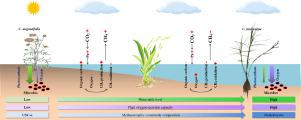Water Research ( IF 11.4 ) Pub Date : 2021-09-23 , DOI: 10.1016/j.watres.2021.117682 Yongxin Lin 1 , Junji Yuan 2 , Deyan Liu 2 , Hojeong Kang 3 , Chris Freeman 4 , Hang-Wei Hu 5 , Guiping Ye 6 , Weixin Ding 2

|
Elevated atmospheric CO2 may have consequences for methane (CH4) emissions from wetlands, yet the magnitude and direction remain unpredictable, because the associated mechanisms have not been fully investigated. Here, we established an in situ macrocosm experiment to compare the effects of elevated CO2 (700 ppm) on the CH4 emissions from two wetlands: an intermittently inundated Calamagrostis angustifolia marsh and a permanently inundated Carex lasiocarpa marsh. The elevated CO2 increased CH4 emissions by 27.6–57.6% in the C. angustifolia marsh, compared to a reduction of 18.7–23.5% in the C. lasiocarpa marsh. The CO2-induced increase in CH4 emissions from the C. angustifolia marsh was paralleled with (1) increased dissolved organic carbon (DOC) released from plant photosynthesis and (2) reduced (rate of) CH4 oxidation due to a putative shift in methanotrophic community composition. In contrast, the CO2-induced decrease in CH4 emissions from the C. lasiocarpa marsh was associated with the increases in soil redox potential and pmoA gene abundance. We synthesized data from worldwide wetland ecosystems, and found that the responses of CH4 emissions to elevated CO2 was determined by the wetland water table levels and associated plant oxygen secretion capacity. In conditions with elevated CO2, plants with a high oxygen secretion capacity suppress CH4 emissions while plants with low oxygen secretion capacity stimulate CH4 emissions; both effects are mediated via a feedback loop involving shifts in activities of methanogens and methanotrophs.
中文翻译:

湿地甲烷排放对大气 CO2 升高的不同响应取决于地下水位
大气 CO 2升高可能会对湿地的甲烷 (CH 4 ) 排放产生影响,但其大小和方向仍然不可预测,因为相关机制尚未得到充分研究。在这里,我们建立了一个原位宏观实验来比较升高的 CO 2 (700 ppm) 对来自两个湿地的 CH 4排放的影响:间歇性淹没的Calamagrostis angustifolia沼泽和永久淹没的Carex lasiocarpa沼泽。升高的 CO 2使C. angustifolia 的CH 4排放量增加了 27.6–57.6%沼泽,相比之下C. lasiocarpa沼泽减少了 18.7-23.5% 。CO 2诱导的C. angustifolia沼泽的CH 4排放增加与 (1) 植物光合作用释放的溶解有机碳 (DOC) 增加和 (2)由于假定的转变而降低的 CH 4氧化(速率)平行在甲烷营养群落组成中。相比之下,C. lasiocarpa沼泽中CO 2诱导的CH 4排放减少与土壤氧化还原电位和pmoA基因丰度的增加有关。我们综合了全球湿地生态系统的数据,发现 CH 的响应4排放到升高的 CO 2是由湿地地下水位水平和相关的植物氧气分泌能力决定的。在CO 2升高的条件下,高氧分泌能力的植物抑制CH 4排放,而低氧分泌能力的植物刺激CH 4排放;这两种效应都是通过一个反馈回路介导的,该回路涉及产甲烷菌和甲烷氧化菌活动的变化。











































 京公网安备 11010802027423号
京公网安备 11010802027423号